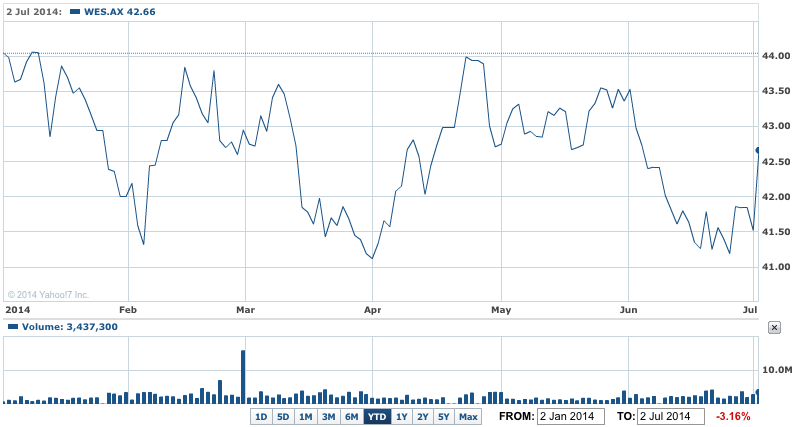Confession is supposed to be good for the soul and looking at the way Wesfarmers’ (WES) share price rose yesterday after the company sprung a near $700 million write-down in value of it’s faltering Target department store chain, you’d have to say that confession is also good for the share price.
But it also pays to confess on a day when traders decide to catch the global surge in the market that we missed on July 1, but which offshore investors found overnight Tuesday and pushed share prices to new highs on Wall Street.
Wesfarmers share price rose 2.7% to $42.66, a rise of $1.14 – the wider market was up a very solid 1.5%, or 79 points.
Had Wesfarmers revealed the write-down (which has been offset against the profit made on selling most of its insurance underwriting businesses) on Monday or Tuesday, then investors might not have been so accommodating and the share price could have taken a bit of whacking.
But as usual it’s all in the timing and Wesfarmers got it right yesterday as it become yet another company to separate bad news, from a good news event such as its 2013-14 annual profit announcement in mid August.
That would have clouded the reaction to the profit report – now Wesfarmers management can handle the forecast plunge in Target’s profit by saying that the ‘bad medicine’ has been taken and its now looking to the future, not looking at the past.
Wesfarmers also cut the value of its liquor business by $94 million – it had been a rumoured seller a month or so ago.
But the write-down seems to indicate that liquor is going to be retained.
WES YTD – Wesfarmers uses insurance profit for some housekeeping

The core part of yesterday’s announcement was that Wesfarmers had cut the value of goodwill at discount department store chain Target by $680 million and booked those restructuring costs of $94 million against the underperforming liquor business after reviewing future earnings.
The company explained the cut:
"This impairment charge to goodwill represents 35.2 per cent of Target’s carrying amount of allocated goodwill at 30 June 2013, and 4.5 per cent of the Group’s carrying amount of goodwill at 30 June 2013 (excluding goodwill associated with the Insurance division).
"The impairment charge is non-cash in nature and largely reflects an increase in the risk- adjusted discount rate applied to Target’s expected future cash flows," directors said.
“Notwithstanding the revision to Target’s carrying value, we are pleased with the progress that has been made over the last 12 months in materially strengthening Target’s leadership team and we consider there to be many opportunities to significantly improve Target’s performance,” Wesfarmers Managing Director Richard Goyder said.
"This non-cash impairment charge will have no impact on Wesfarmers’ normal business operations and development," directors said.
In other words, it’s an accounting charge, so the full amount from the insurance sale will remain in Wesfarmers’s bank account – around $2 billion or so.
Wesfarmers offset the write-downs and provisions against a pre-tax profit of between $1.03 billion and $1.08 billion on the sale of its insurance operations.
That will leave a net profit on that sale of $261 million to $310 million in the full year report (that’s a pre-tax estimate, and a series of accounting entries).
And directors said Target’s full year earnings before interest and tax are now expected to be in the range of $82 to $88 million – or $52 million under the $136 million earned in 2012-13 (and nearly two third less than the $244 million earned the year before).
Seeing Target earned $70 million in the six months to December, the $82 to $88 million means the chain was barely profitable in the second half – with earnings around $12 to $18 million, which is risible for a retailer with billions of dollars in sales.













